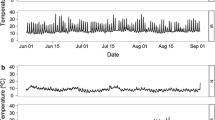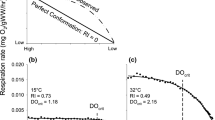Abstract
Studies of the importance of ecosystem engineers have focused on their benefit to biodiversity through ameliorating environmental stress, without understanding the exact benefits gained by associated organisms. On monsoonal tropical shores, species experience strong seasonality in environmental conditions from almost temperate winters to tropical summers when mass mortalities can occur during daytime emersion. The limpet, Cellana grata, associates with an ecosystem engineer, the barnacle Tetraclita japonica, in summer, but not in winter. To understand the benefits of this association, physiological responses (heart rates and osmotic responses) of the limpet either amongst Tetraclita or on open rock surfaces were investigated under three environmental conditions in a laboratory mesocosm: awash (non-stressed), low (30 °C) and high thermal stress (40 °C) of varying durations (3 or 6 h). In general, at 30 °C, limpets showed similar physiological responses under all conditions for both exposure durations. After 6 h at 40 °C, however, all limpets on open rock surfaces died, whereas those associated with barnacles survived. The surviving limpets experienced similar levels of stress as those exposed to 40 °C on open rock surfaces for half the time (3 h), showing that both the level and duration of stress were important. Limpets, therefore, gain benefits from engineering species when conditions are extreme or stress is prolonged. Under low temperatures or for short durations (e.g. winter), associating with barnacles does not provide physiological benefits. Understanding how, and to what extent, associates benefit from ecosystem engineers highlights how close the margin between survival and mortality can be when conditions are extreme.


Similar content being viewed by others
References
Bertness MD, Leonard GH (1997) The role of positive interactions in communities: lessons from the intertidal. Ecology 78:1978–1989
Bertness MD, Leonard GH, Levine JM, Schmidt PR, Ingraham AO (1999) Testing the relative contribution of positive and negative interactions in rocky intertidal communities. Ecology 80:2711–2726
Borthagaray AI, Carranza A (2007) Mussels as ecosystem engineers: their contribution to species richness in a rocky littoral community. Acta Oecol 31:243–250
Brosnan DM (1992) Ecology of tropical rocky shores: Plant-animal interactions in tropical and temperate latitudes. In: John DM, Hawkins SJ, Price JH (eds) Plant-animal interactions in the marine benthos, vol 46. Clarendon Press, Oxford, pp 101–131
Bruno JF, Stachowicz JJ, Bertness MD (2003) Inclusion of facilitation into ecological theory. Trends Ecol Evol 18:119–125
Bulleri F (2009) Facilitation research in marine systems: state of the art, emerging patterns and insights for future developments. J Ecol 97:1121–1130
Burnaford JL (2004) Habitat modification and refuge from sublethal stress drive a marine plant-herbivore association. Ecology 85:2837–2849
Cartwright SR (2010) Facilitation of intertidal species against environmental stress by the barnacle Tetraclita japonica japonica on Hong Kong’s tropical rocky shores. PhD thesis, The University of Hong Kong, Hong Kong
Cartwright SR, Williams GA (2012) Seasonal variation in utilization of biogenic microhabitats by littorinid snails on tropical rocky shores. Mar Biol 159:2323–2332
Cartwright SR, Coleman RA, Browne MA (2006) Ecologically relevant effects of pulse application of copper on the limpet Patella vulgata. Mar Ecol Prog Ser 325:187–194
Castilla JC, Lagos NA, Cerda M (2004) Marine ecosystem engineering by the alien ascidian Pyura praeputialis on a mid-intertidal rocky shore. Mar Ecol Prog Ser 268:119–130
Cavieres LA, Badano EI, Sierra-Almeida A, Gómez-González S, Molina-Montenegro M (2006) Positive interactions between alpine plant species and the nurse cushion plant Laretia acaulis do not increase with elevation in the Andes of central Chile. New Phyto 169:59–69
Chan BKK, Morritt D, De Pirro M, Leung KMY, Williams GA (2006) Summer mortality: effects on the distribution and abundance of the acorn barnacle Tetraclita japonica on tropical shores. Mar Ecol Prog Ser 328:195–204
Chapperon C, Seuront L (2011) Space-time variability in environmental thermal properties and snail thermoregulatory behaviour. Funct Ecol 25:1040–1050
Crain CM, Bertness MD (2006) Ecosystem engineering across environmental gradients: implications for conservation and management. Bioscience 56:211–218
Dayton PK (1975) Experimental evaluation of ecological dominance in a rocky intertidal algal community. Ecol Monogr 45:137–159
Deutsch CA, Tewksbury JJ, Huey RB, Sheldon KS, Ghalambor CK, Haak DC, Martin PR (2008) Impacts of climate warming on terrestrial ectotherms across latitude. Proc Nat Acad Sci USA 105:6668–6672
Dong YW, Williams GA (2011) Variations in cardiac performance and heat shock protein expression to thermal stress in two differently zoned limpets on a tropical rocky shore. Mar Biol 158:1223–1231
Firth LB, Williams GA (2009) The influence of multiple environmental stressors on the limpet Cellana toreuma during the summer monsoon season in Hong Kong. J Exp Mar Biol Ecol 375:70–75
Fraser CML, Coleman RA, Seebacher F (2014) Trying to fit in: are patterns of orientation of a keystone grazer set by behavioural responses to ecosystem engineers or wave action? Oecologia 174:67–75
Garrity SD (1984) Some adaptations of gastropods to physical stress on a tropical rocky shore. Ecology 65:559–574
Harley CDG, O’Riley JL (2011) Non-linear density dependent effects of an intertidal ecosystem engineer. Oecologia 166:531–541
Harper KD, Williams GA (2001) Variation in abundance and distribution of the chiton Acanthopleura japonica and associated molluscs on a seasonal, tropical, rocky shore. J Zool 253:293–300
Helmuth B (1998) Intertidal mussel microclimates: predicting the body temperature of a sessile invertebrate. Ecol Monogr 68:29–52
Hochachka PW, Somero GN (2002) Biochemical adaptation: mechanism and process in physiological evolution. Oxford University Press, UK, Oxford
Ivlev VS (1961) Experimental ecology of the feeding of fishes. Yale University Press, New Haven
Jones KMM, Boulding EG (1999) State-dependent habitat selection by an intertidal snail: the costs of selecting a physically stressful microhabitat. J Exp Mar Biol Ecol 242:149–177
Jones CG, Lawton JH, Shachak M (1994) Organisms as ecosystem engineers. Oikos 69:373–386
Jones CG, Lawton JH, Shachak M (1997) Positive and negative effects of organisms as physical ecosystem engineers. Ecology 78:1946–1957
Kaehler S, Williams GA (1996) Distribution of algae on tropical rocky shores: spatial and temporal patterns of non-coralline encrusting algae in Hong Kong. Mar Biol 125:177–187
Kawai T, Tokeshi M (2004) Variable modes of facilitation in the upper intertidal: goose barnacles and mussels. Mar Ecol Prog Ser 272:203–213
Kostylev VE, Erlandsson J, Mak MY, Williams GA (2005) The relative importance of habitat complexity and surface area in assessing biodiversity: fractal application on rocky shores. Ecol Comp 2:272–286
Lubchenco J, Menge BA, Garrity SD, Lubchenco PJ, Ashkenas LR, Gaines SD, Emlet R, Lucas J, Strauss S (1984) Structure, persistence, and role of consumers in a tropical rocky intertidal community (Taboguilla Island, Bay of Panama). J Exp Mar Biol Ecol 78:23–73
Marshall DJ, Dong YW, McQuaid CD, Williams GA (2011) Thermal adaptation in the intertidal snail Echinolittorina malaccana contradicts current theory by revealing the crucial roles of resting metabolism. J Exp Biol 214:3649–3657
Morton B (1995) The population dynamics and reproductive-cycle of Septifer virgatus (Bivalvia, Mytilidae) on an exposed rocky shore in Hong Kong. J Zool 235:485–500
Munoz JLP, Finke GR, Camus PA, Bozinovic F (2005) Thermoregulatory behaviour, heat gain and thermal tolerance in the periwinkle Echinolittorina peruviana in central Chile. Comp Biochem Phys A 142:92–98
Ng JSS (2007) Resource partitioning and coexistence of molluscan grazers on Hong Kong rocky shores. PhD thesis, The University of Hong Kong, Hong Kong
Ngan A (2006) Environmental stress and its implications for behavioural plasticity of foraging in Cellana grata. PhD thesis, The University of Hong Kong, Hong Kong
Nicastro KR, Zardi GI, McQuaid CD, Pearson GA, Serrao EA (2012) Love thy neighbour: group properties of gaping behaviour in mussel aggregations. PLoS ONE 7:e47832
Pörtner HO (2012) Integrating climate-related stressor effects on marine organisms: unifying principles linking molecule to ecosystem-level changes. Mar Ecol Prog Ser 470:273–290
Seed R (1996) Patterns of biodiversity in the macro-invertebrate fauna associated with mussel patches on rocky shores. J Mar Biol Ass UK 76:203–210
Segal E, Dehnel PA (1962) Osmotic behaviour in an intertidal limpet, Acmaea limatula. Biol Bull (Woods Hole) 122:417–430
Somero GN (2002) Thermal physiology and vertical zonation of intertidal animals: optima, limits, and costs of living. Integr Comp Biol 42:780–789
Stillman JH (2003) Acclimation capacity underlies susceptibility to climate change. Science 301:65
Tewksbury JJ, Huey RB, Deutsch CA (2008) Putting the heat on tropical animals. Science 320:1296
Thompson RC, Wilson BJ, Tobin ML, Hill AS, Hawkins SJ (1996) Biologically generated habitat provision and diversity of rocky shore organisms at a hierarchy of spatial scales. J Exp Mar Biol Ecol 202:73–84
Underwood AJ (1997) Experiments in ecology: their logical design and interpretation using analysis of variance. Cambridge University Press, Cambridge
Underwood AJ (1999) Physical disturbances and their direct effect on an indirect effect: responses of an intertidal assemblage to a severe storm. J Exp Mar Biol Ecol 232:125–140
Williams GA (1994) The relationship between shade and molluscan grazing in structuring communities on a moderately-exposed tropical rocky shore. J Exp Mar Biol Ecol 178:79–95
Williams GA, McMahon BR (1996) Haemolymph pH and oxygen levels in a naturally stressed tropical limpet, Cellana grata. The Marine Biology of the South China Sea. Proceedings of the Third International Conference on the Marine Biology of the South China Sea. In Morton B (eds), pp. 239–245. Hong Kong University Press, Hong Kong
Williams GA, Morritt D (1995) Habitat partitioning and thermal tolerance in a tropical limpet, Cellana grata. Mar Ecol Prog Ser 124:89–103
Williams GA, De Pirro M, Leung KMY, Morritt D (2005) Physiological responses to heat stress on a tropical shore: the benefits of mushrooming behaviour in the limpet Cellana grata. Mar Ecol Prog Ser 292:213–224
Williams GA, De Pirro M, Cartwright SR, Khangura K, Ng WC, Leung PTY, Morritt D (2011) Come rain or shine: the combined effects of physical stresses on physiological and protein-level responses of an intertidal limpet in the monsoonal tropics. Funct Ecol 25:101–110
Acknowledgments
Thanks to Professor CD McQuaid (University of Rhodes, South Africa) and the Hard Rock Ecology Group (HKU) for comments improving the manuscript and Ms Cecily Law for assistance in preparing the experiments. This work was conducted in partial fulfilment of a PhD degree by SRC who was supported by a postgraduate studentship at The University of Hong Kong.
Author information
Authors and Affiliations
Corresponding author
Additional information
Communicated by M.G. Chapman.
Rights and permissions
About this article
Cite this article
Cartwright, S.R., Williams, G.A. How hot for how long? The potential role of heat intensity and duration in moderating the beneficial effects of an ecosystem engineer on rocky shores. Mar Biol 161, 2097–2105 (2014). https://doi.org/10.1007/s00227-014-2489-4
Received:
Accepted:
Published:
Issue Date:
DOI: https://doi.org/10.1007/s00227-014-2489-4




